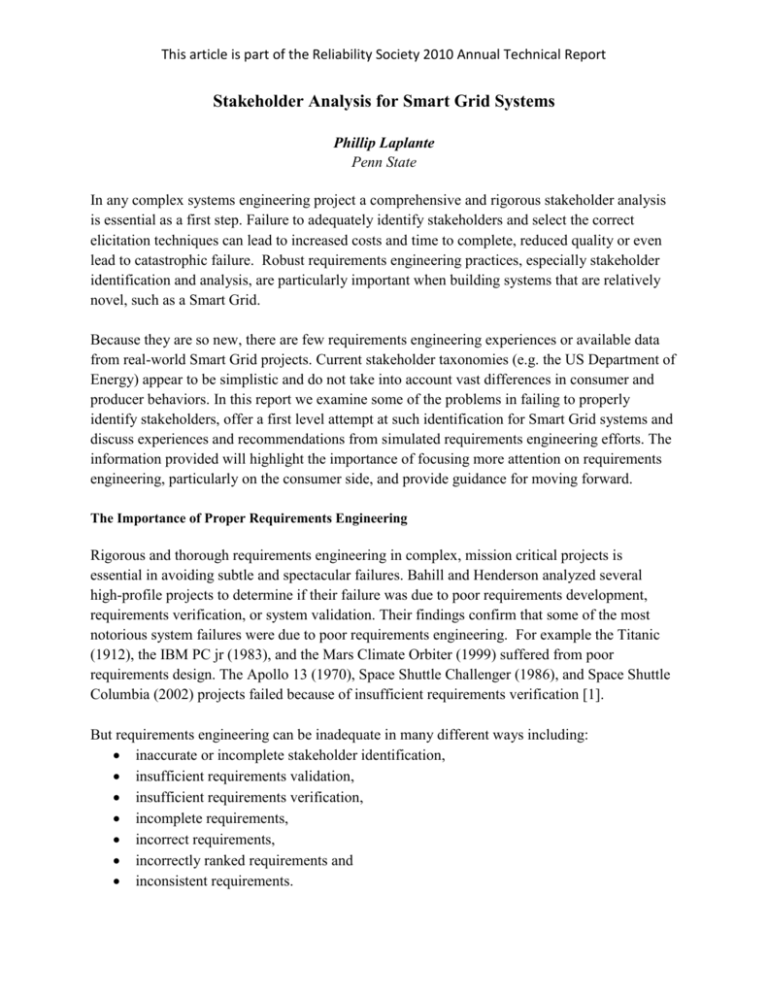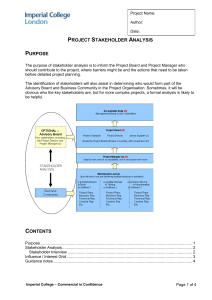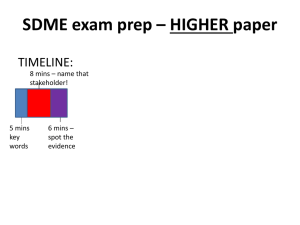Stakeholder Analysis for Smart Grid Systems
advertisement

This article is part of the Reliability Society 2010 Annual Technical Report Stakeholder Analysis for Smart Grid Systems Phillip Laplante Penn State In any complex systems engineering project a comprehensive and rigorous stakeholder analysis is essential as a first step. Failure to adequately identify stakeholders and select the correct elicitation techniques can lead to increased costs and time to complete, reduced quality or even lead to catastrophic failure. Robust requirements engineering practices, especially stakeholder identification and analysis, are particularly important when building systems that are relatively novel, such as a Smart Grid. Because they are so new, there are few requirements engineering experiences or available data from real-world Smart Grid projects. Current stakeholder taxonomies (e.g. the US Department of Energy) appear to be simplistic and do not take into account vast differences in consumer and producer behaviors. In this report we examine some of the problems in failing to properly identify stakeholders, offer a first level attempt at such identification for Smart Grid systems and discuss experiences and recommendations from simulated requirements engineering efforts. The information provided will highlight the importance of focusing more attention on requirements engineering, particularly on the consumer side, and provide guidance for moving forward. The Importance of Proper Requirements Engineering Rigorous and thorough requirements engineering in complex, mission critical projects is essential in avoiding subtle and spectacular failures. Bahill and Henderson analyzed several high-profile projects to determine if their failure was due to poor requirements development, requirements verification, or system validation. Their findings confirm that some of the most notorious system failures were due to poor requirements engineering. For example the Titanic (1912), the IBM PC jr (1983), and the Mars Climate Orbiter (1999) suffered from poor requirements design. The Apollo 13 (1970), Space Shuttle Challenger (1986), and Space Shuttle Columbia (2002) projects failed because of insufficient requirements verification [1]. But requirements engineering can be inadequate in many different ways including: inaccurate or incomplete stakeholder identification, insufficient requirements validation, insufficient requirements verification, incomplete requirements, incorrect requirements, incorrectly ranked requirements and inconsistent requirements. In this report we focus only on the problem of stakeholder identification and on finding appropriate elicitation techniques for each stakeholder group for a Smart Grid system. Identifying Stakeholders A concept of operations for a Smart Grid can be stated as: “An automated, widely distributed energy delivery network, the Smart Grid will be characterized by a two-way flow of electricity and information and will be capable of monitoring everything from power plants to customer preferences to individual appliances. It incorporates into the grid the benefits of distributed computing and communications to deliver real-time information and enable the near-instantaneous balance of supply and demand at the device level” [2]. Equipped with a concept of operations statement, the next step in the systems engineering process involves identifying all positive and negative stakeholders. Positive stakeholders are those who are likely to benefit from the new system. Negative stakeholders are those who may be adversely affected by the development of the new system, for example, competitors, potentially displaced workers and gadflies [3]. Conventional stakeholder identification A common approach to identifying stakeholders for new systems involves answering a set of questions: Who is paying for the system? Who is going to use the system? Who is going to judge the fitness of the system for use? What agencies (government) and entities (non-government) regulate any aspect of the system? What laws govern the construction, deployment, and operation of the system? Who is involved in any aspect of the specification, design, construction, testing, maintenance and retirement of the system? Who will be negatively affected if the system is built? Who else cares if this system exists or doesn’t exist? Who have we left out? [3] But experience from several simulated stakeholder analysis efforts (conducted by this author’s graduate students – most working software engineers) suggest that answering this set of questions can lead to a set of stakeholder groups is too course grained. For example, one such 2 taxonomy corresponds to the United States Department of Energy’s stakeholder groups for a Smart Grid in a public facing document on the project: Consumer advocates, Utilities, Technology Providers, Regulators, Policy Makers and Environmental Groups [2]. In order to avoid a coarse grained stakeholder analysis, intensive focus groups and other structured brainstorming activities are required. Simulated intensive stakeholder analysis Consumer advocates are supposed to represent the voice of the energy consumer. But energy “consumers” are a very diverse group. A simulated deep stakeholder analysis using brainstorming, introspection, and interviews revealed numerous layers of sub-stakeholder groups for a Smart Grid system. A partial result of the stakeholder analysis activities are shown in Figure 1. 3 Figure 1 Partial, simulated stakeholder groups for a Smart Grid system. There is a great deal missing from Figure 1, however. Government is a huge consumer of energy and is not represented. Negative stakeholders are also not represented, for example, Consideration of other factors suggests that there is more to the stakeholder analysis than implied by Figure 1. For example, individual homeowners consume energy differently from one other based on a host of factors including socioeconomic status, race, ethnicity, education, residential setting (urban, suburban, rural) and many other factors [4]. Marketing professionals are well aware of these consumption behavioral differences, and it would be worthwhile for an interdisciplinary team to conduct the stakeholder analysis, not just engineers. A rigorous stakeholder analysis needs to be conducted for the Consumers stakeholder group and then for Utilities, Technology Providers, Regulators, Policy Makers and Environmental Groups. Then representatives for each stakeholder group need to be identified and included in various requirements elicitation, verification and validation activities. Requirements elicitation Obtaining a set of raw requirements from stakeholder group representatives is not easy. While some requirements are obvious and can be gathered or collected like low-hanging fruit, many other requirements are hidden or not readily offered. Stakeholders often do not know what they really want or they may change their mind. Sometimes stakeholders deliberately withhold information from the requirements engineer because of some personal agenda. Still other requirements are non-obvious and must be derived somehow from the requirements we can obtain. Therefore, we need various techniques to elicit, that is, to tease out these requirements from confused, unwilling, uninformed, vacillating, or conflicted stakeholders. The wide range of available elicitation techniques must be matched to the abilities and characteristics of the stakeholder group. Table 1 presents a summary of some widely used elicitation techniques and how these techniques inform that requirements engineering effort. Technique Brainstorming Card Sorting Designer as Apprentice Domain Analysis Ethnographic Observation Goal Based Understanding the domain √ Identifying sources of requirements √ √ √ √ √ √ √ √ Analyzing stakeholders √ Eliciting requirements √ √ √ √ √ √ √ √ 4 Approaches Group Work Interviews Introspection Join Application Development (JAD) Laddering Protocol Analysis Prototyping Quality Function Deployment (QFD) Questionnaires Repertory Grids Scenarios Task Analysis User Stories Viewpoints Workshops √ √ √ √ √ √ √ √ √ √ √ √ √ √ √ √ √ √ √ √ √ √ √ √ √ √ √ √ √ √ √ √ √ √ √ √ √ √ √ √ √ √ √ √ √ √ Table 1: Elicitation techniques and how they inform requirements engineering [3]. For example, certain consumer groups, such as the elderly and children need more informal approaches such as brainstorming, user stories and interviews than more technical approaches such as repertory grids and questionnaires. Each of the techniques in shown in Table 1 has advantages and disadvantages with respect to different stakeholder groups. But these disadvantages can be mitigated by selecting the right mix of complimentary and supporting techniques. For example, interviews and viewpoints analysis are complimentary while interviews and prototyping are supporting. But there is another problem in deciding on the appropriate mix of elicitation activities subject to the constraints of budget, stakeholder access, effort level and so forth. Once the elicitation activities have been conducted, the requirements need to be reconciled. Different stakeholder agendas will create incompatible and inconsistent requirements. The stakeholders need to be ranked based on a number of factors in order to conduct tradeoff studies, to resolve requirements conflicts and make appropriate cost-benefit decisions later when requirements are found to be too costly or impractical to meet. Conclusion Experiences in creating requirements for simulated systems such as the Smart Grid, indicate trouble in identifying stakeholders and applicable standards, laws, statutes and regulations. Even 5 upon collecting a set of stakeholder needs and regulatory constraints and standards based requirements, there is likely to be confusion and conflict. We need to insure that all stakeholder groups are precisely identified, studied, and proper elicitation techniques used before we can proceed with building any Smart Grid system. A comprehensive stakeholder analysis activity needs to be conducted prior to other engineering activities. References [1] A. Terry Bahill and Steven J. Henderson, “Requirements development, verification and validation exhibited in famous failures,” Syst. Eng. vol. 8, no. 1, 2005, pp. 1–14. [2] US Department of Energy, Office of Electricity Delivery and Energy Reliability,“ The Smart Grid: An Introduction,” 2008, available at http://www.oe.energy.gov/DocumentsandMedia/DOE_SG_Book_Single_Pages(1).pdf, last accessed December 29, 2010. [3] Phillip A. Laplante, Requirements Engineering for Software and Systems, CRC/Taylor & Francis, 2009. [4] Acxiom, Corp., “Retail Consumer Dynamics Study,” October 2008, available at http://www.consumerresearchsite.com/documents/Retail_Consumer_Dynamics_Study.pdf, last accessed December 29, 2010. 6








